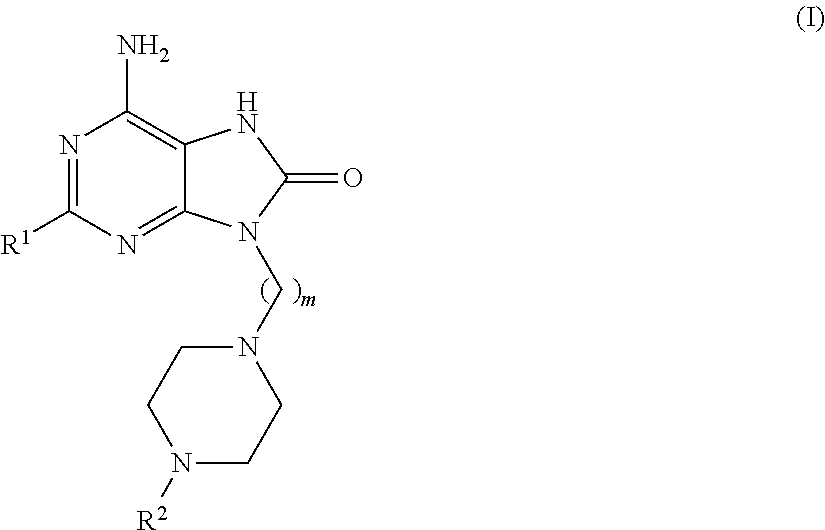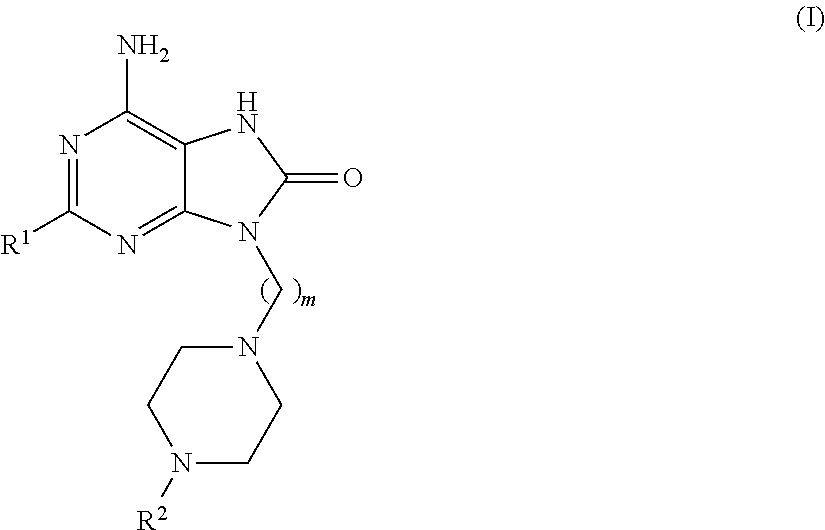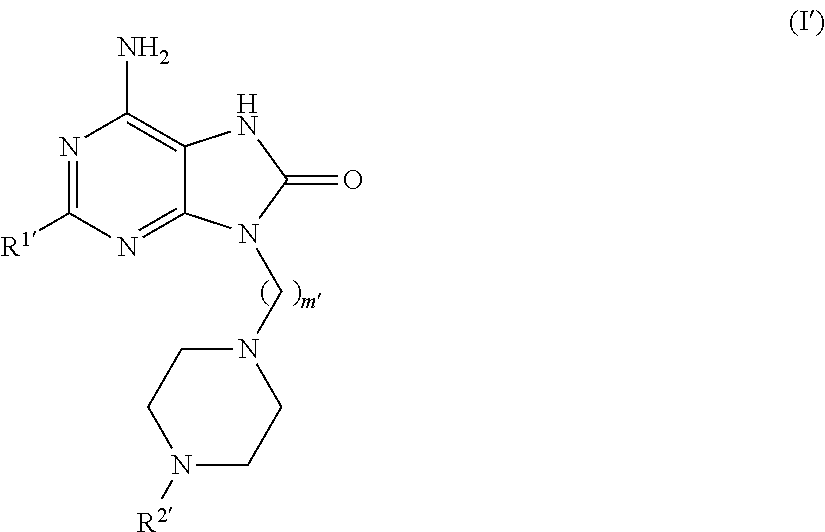Purine derivatives for use in the treatment of allergic, inflammatory and infectious diseases
a technology of purine derivatives and infectious diseases, applied in the direction of antibody medical ingredients, drug compositions, immunological disorders, etc., can solve the problems of disease modification, failure to show sustained viral response, and inability to control viral load
- Summary
- Abstract
- Description
- Claims
- Application Information
AI Technical Summary
Benefits of technology
Problems solved by technology
Method used
Image
Examples
example 1
6-Amino-2-(butyloxy)-9-[2-(1-piperazinyl)ethyl]-7,9-dihydro-8H-purin-8-one dihydrochloride salt
[0650]
[0651]1,1-Dimethylethyl 4-{2-[6-amino-2-(butyloxy)-8-(methyloxy)-9H-purin-9-yl]ethyl}-1-piperazinecarboxylate (124 mg, 0.276 mmol) was suspended in methanol (2 ml) and 4M hydrogen chloride in 1,4-dioxane (1 ml) was slowly added and the resulting solution stirred at room temperature. After 1 hour a thick suspension was formed and after 2 hours the solvent was evaporated. The residue was purified by silica gel chromatography eluting initially with chloroform:methanol:water 90:10:1 then 85:15:1 then 82:18:1 then 80:20:1 and finally 75:25:1. Product-containing fractions were combined and evaporated to give the title compound as a white solid (87 mg).
[0652]LCMS (System D): tRET=1.80 min; MH+=336
example 2
6-Amino-2-(butyloxy)-9-[2-(4-cyclohexyl-1-piperazinyl)ethyl]-7,9-dihydro-8H-purin-8-one dihydrochloride salt
[0653]
[0654]2-(Butyloxy)-9-[2-(4-cyclohexyl-1-piperazinyl)ethyl]-8-(methyloxy)-9H-purin-6-amine (88 mg, 0.24 mmol), methanol (1 ml) and 4M hydrogen chloride in 1,4-dioxane (5 ml) was stirred at room temperature overnight. The solvent was evaporated in vacuo to give the title compound as a white solid (119 mg).
[0655]LCMS (System B): tRET=1.35 min; MH+=418
example 3
6-Amino-2-(butylamino)-9-[2-(4-methyl-1-piperazinyl)ethyl]-7,9-dihydro-8H-purin-8-one
[0656]
[0657]A solution of 9-(2-bromoethyl)-N2-butyl-8-(methyloxy)-9H-purine-2,6-diamine (150 mg, 0.437 mmole) and 1-methylpiperazine (131 mg, 1.311 mmole) in methanol (10 ml) was heated under reflux for 16 hours. The solvent was evaporated and the product purified by preparative TLC to give the intermediate 8-methoxy derivative (90 mg) which was dissolved in methanol (5 ml) and treated with a solution of hydrogen chloride in 1,4-dioxane (0.5 ml). After 16 hours the solvent was evaporated and the residue adjusted to pH 7-8 with sodium carbonate solution and extracted with ethyl acetate. The organic extract was evaporated and the residue purified by preparative HPLC to give the title compound (36 mg).
[0658]LCMS (System B): tRET=0.81 min; MH+=349
PUM
| Property | Measurement | Unit |
|---|---|---|
| weight | aaaaa | aaaaa |
| temperature | aaaaa | aaaaa |
| pharmaceutical composition | aaaaa | aaaaa |
Abstract
Description
Claims
Application Information
 Login to View More
Login to View More - R&D
- Intellectual Property
- Life Sciences
- Materials
- Tech Scout
- Unparalleled Data Quality
- Higher Quality Content
- 60% Fewer Hallucinations
Browse by: Latest US Patents, China's latest patents, Technical Efficacy Thesaurus, Application Domain, Technology Topic, Popular Technical Reports.
© 2025 PatSnap. All rights reserved.Legal|Privacy policy|Modern Slavery Act Transparency Statement|Sitemap|About US| Contact US: help@patsnap.com



